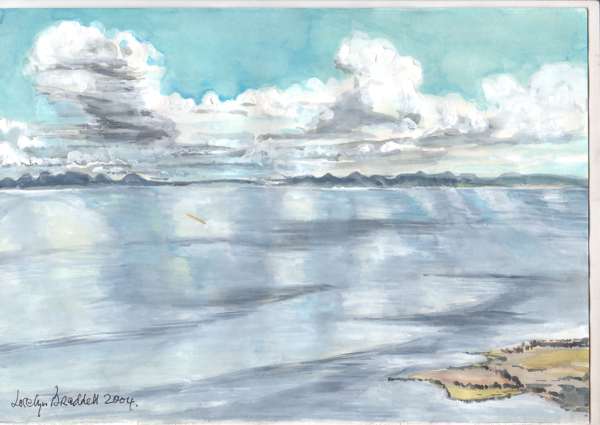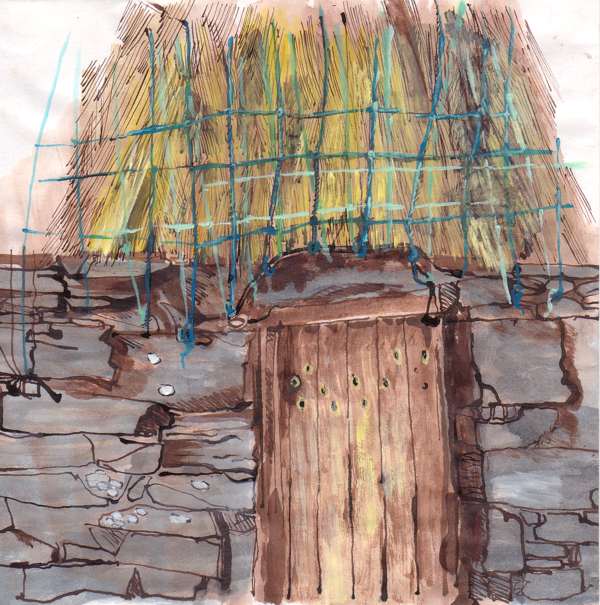
JUNE 2004

some sketches
in Inis Meann, Galway, Ireland
The interesting break up of huge cubes of rock on the
coasts here give an awesome, even threatening aspect to
the island....
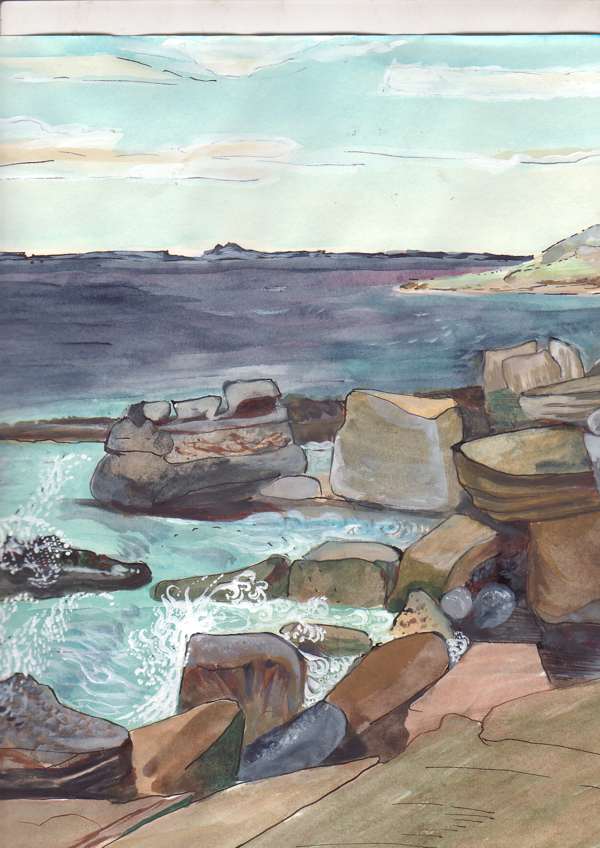
There are however few images to find of the thatched
houses of the recent past and this house recently had
that thatch lascerated by storms. This house was where
the relatives of the "Playboy" of the Western
World once lived (re. John M,Synge's play), and below is
depicted the crevice in which the islanders hid him from
the Aranmore police before he was fleeing to safety in
America.
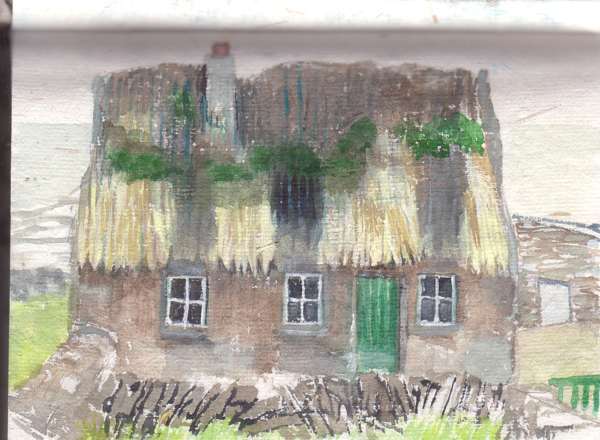
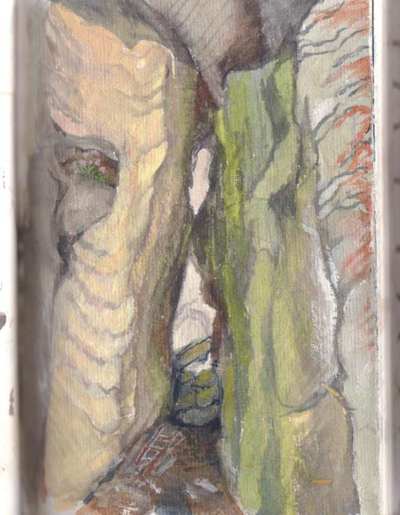 Also in the past a
solitary hermit once lived in this cell and there is a
well nearby and little walled gardens where, perhaps, he
grew herbs .
Also in the past a
solitary hermit once lived in this cell and there is a
well nearby and little walled gardens where, perhaps, he
grew herbs .
In relation to religious matters; the island men built a
road from the first townland encountered on landing at
the pier, this road with a sheltering wall was was a year
or so ago almost eradicated, it leads to the ancient
churchyard where the chapel built in the earliest
centuries of the advent of christianity has some
interesting features.
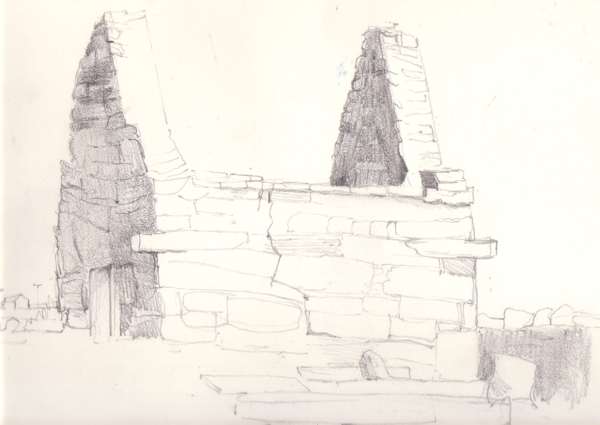
The alterstone is one massive piece of stone that runs
the entire width in this small chapel wall and there was
possibly a channel beneath it, or gutter. There is also a
small peaked window above it. As you can see here the
long protruding stones at the ends of the walls imitate
the carrying poles of The Ark of the Covenant which these
early chapels emulate. The entry door is low and only two
and a half feet wide. It is surely one of the oldest
examples of its kind in Ireland. There is a gravestone
the head of which is cut in three leaves as a trefoil and
has a hole in the central shaft which diminishes into a
rough point where it once entered the rocks to be
supported. It is now thrown over. There is also a well in
the vicinity which has an outlet in the field nearby but
has its original position of grace as a Holy Well under a
large canopy of stone at the base of the palisade of
cliffstones near the church. When we found it, it was
glittering with bright green gems floating on the water,
they turned out to be miniscule green beetles drowning
there.
And on the ice-crested heights of Armenia,
And in the valleys of broad Abyssinia,
Still spake the Oracle just as before -
Wouldst thou have peace, leave the world to its obstinacy
Things to their natures and fools to their folly.
Beetles were blind in the ages of yore..A Song
from the Coptic J.Clarence Mangan
The churchyard road was destroyed when the new pier for
deep lading was built. Now there is 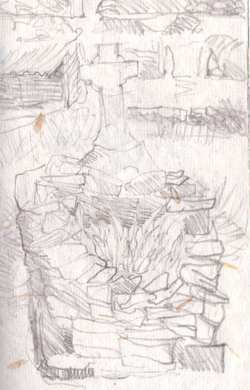
another churchyard on the sandhills to the east of the
pier overlooking the strand between Inish Meann and Inish
Oirr, the smallest island, (where in contrast to the
other islands Irish with a CoClare accent is spoken).This
drawing is of the grave of a woman Saint Cinnhearg which
is by a derelict chapel full of weedgrowth near the
priest's house in the townland of Baile an Lisin.The
Chapel is called Teanpall na Scheacht Mac Ri - the Church
of the Kings Seven Sons.
The fields are full of magnificent cows running with
calves and there are hundreds of these stone walled
fields. Previous to the English occupation of Ireland the
island resolved all agricultural matters communally as
regards to grazing and materials for food and roof
thatching and grain. However during the English
occupations life changed; the English wished to break up
these communities, and it was decreed that families
should allocate fields and build walls which were grant
paid to the farmers at £2 per 22 yards of wall. This is
the way new walls were built:
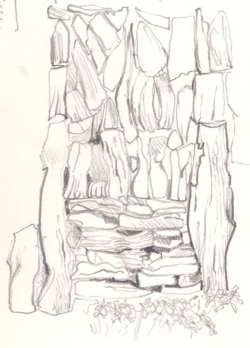 Thus miles and miles of small
fields were created on the Aran Islands and where those
walls spread over the barren rock these fantastic people
continued to create fertile fields with extraordinary
patience breaking rock surfaces,spreading seaweeds,
burning sea weeds that had been harvested and collected
for drying in rock temples (no less) of which one remains
on the eastern shorelands, and mixing in sand and the
sediments full of broken shells that were pounded by
storms on the rocks, providing a calcareous material for
seeding and manuring
Thus miles and miles of small
fields were created on the Aran Islands and where those
walls spread over the barren rock these fantastic people
continued to create fertile fields with extraordinary
patience breaking rock surfaces,spreading seaweeds,
burning sea weeds that had been harvested and collected
for drying in rock temples (no less) of which one remains
on the eastern shorelands, and mixing in sand and the
sediments full of broken shells that were pounded by
storms on the rocks, providing a calcareous material for
seeding and manuring
However, the concept of an island commune was never
broken and it is the Communal Achievement on Inis Meann
that now, having collaborated with the Galway County
Council both by work and finance, the Island Council
provides all electricity needs from three windmills on
the West coast and also the island's natural water supply
is supplemented by a watertreatment plant that provides
pure water from the sea. I saw this machine, of
incredible complexity, the only one in Ireland, a smaller
version of those that are used in Saudi Arabia. Seanin
Faharta also opened the door of a windmill and we entered
but did not climb up a ladder into these elegant organs
of the wind. Seanin has a considerable job there as
detailed records have to be kept everyday of the combined
output of electricity and water and repairs have to be
alerted. Indeed as this water is actually a supplement to
the island's own spring wells that are piped to huge
reservoirs, I question the Galway County Council who, it
is said, plan to metre water on this island. If perhaps
the manufactured intake from the sea should be metred,why
should the houses pay any more than a trifle on that
yearly input - otherwise they would be robbed, or paying
for their own island resource waters - a blessing of
nature.Metreing would be unfair also for those providing
Bed and Breakfast or lodgings for the short summer period
to modern tourists, whose incredible hygeine regime
demands showers, sometimes twice a day, etc.. A use of
water that they could never be charged for.
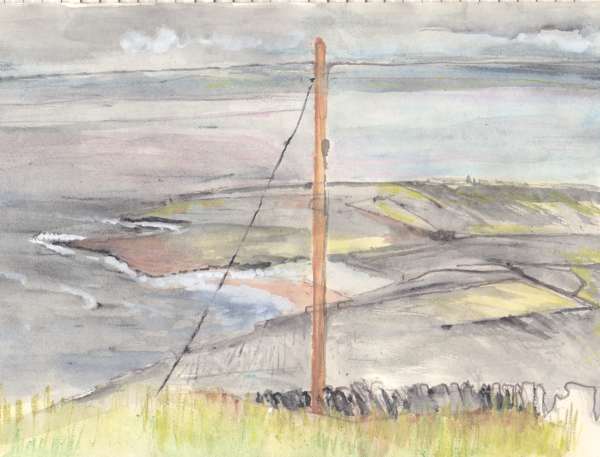
As it is modern life is too attractive for the young, and
when the generation of children that is now in their mid
thirties left Inis Meann ,( they were "the mental
and physical cream of our island people"), the large
school population gradually dropped to the present
handful of primary school children. The islanders
recently secured secondary education premises and pupils
were taking their end of term exams while I was there.
There is also expertise in language teaching available
for large groups of teenagers, that are regularly in
residence in accomodation provided for them, for courses
of 3-4 weeks length.But if the young people decline to
stay how will these advantages so recently undertaken be
maintained?
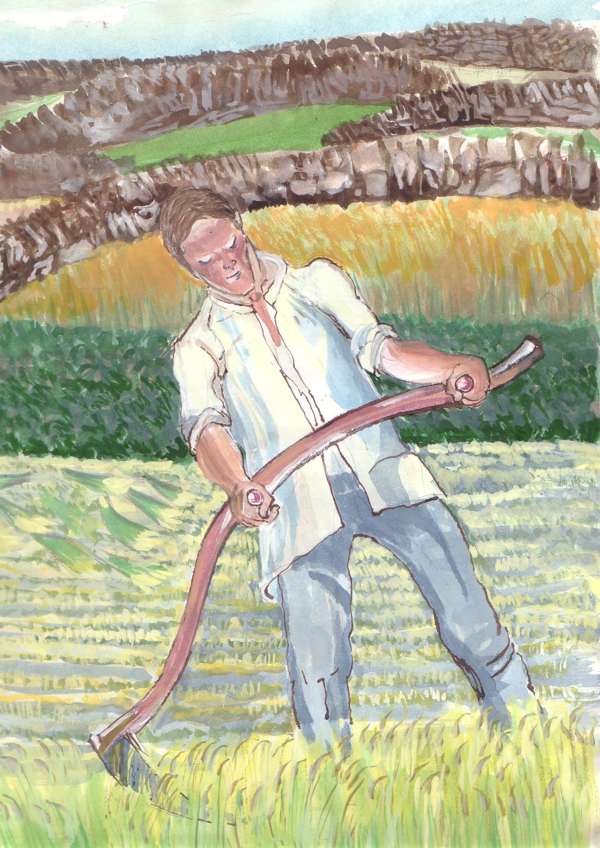
The hay is still cut with the scythe.The local fisherman
still make the beautiful timber and canvas curraghs from
which they work their lobster and crab traps; a man must
stand up in these wildest wave leaping boats to cast out
their traps that are marked by bouys.
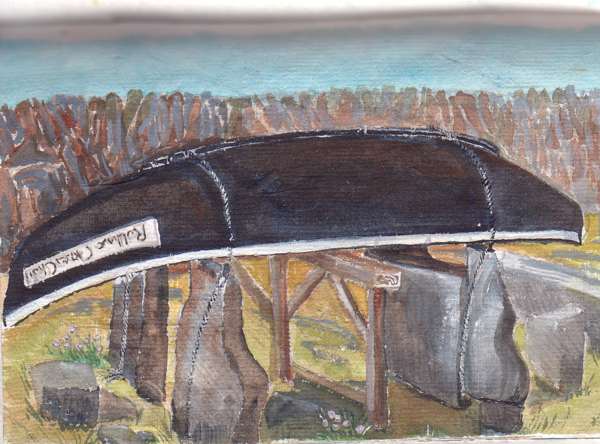
The very house and domestic properties of the family that
housed the first Irish language school, where, among many
others, Padraig Pearce, Tomas Mac Donnagh, Eoin MacNeill,
William Butler Yeats and Kuno Meyer the German scholar
had all been visitors, is still in existence as a small
Museum.. There lived the writer John M.Synge who wrote
three strong plays from stories he was told by his
friends and hosts here. The house is maintained by Treasa
Ni Fhatharta who is the grandaughter of John Synge's
friend and mentor which can be visted, she has collected
photos also and the atmosphere of past times is
completely represented, the thick indigo coloured
hand-knitted socks hanging over the fire, the red flannel
skirts on a hook, the beautiful Lustre Jugs made for jam
gleaming on the dresser, the fishing nets in the rafters.
Treasa has annecdotes to tell handed down by her father
and mother and for a moment the illusion persists that
the man himself may be sitting on the bed in the
"best" room writing his letters and diaries.
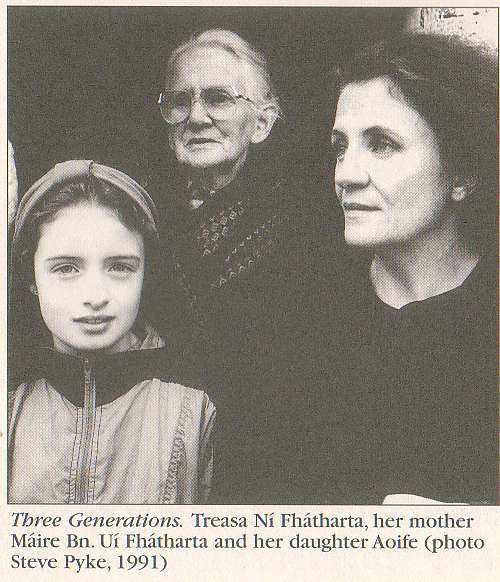
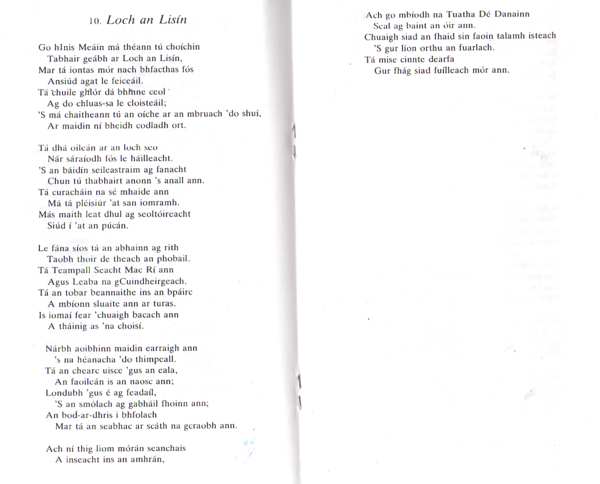
The Poet Dara O Fatharta
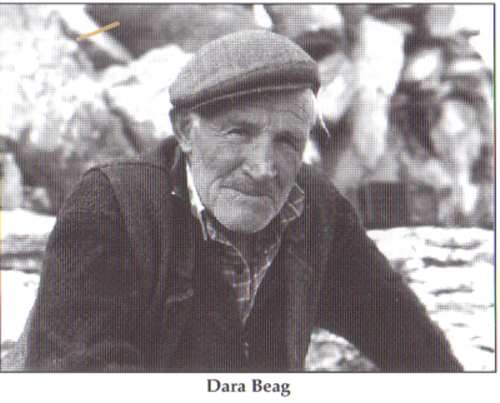
Thank you Moira and Seanin Fatharta, Treasa, Dara Beag
and all the islanders with whom I had the privilege to
speak, who minded not atall that I had not a word of
their language. Your enormous St.John's Night fire that
was still smoking in the dawn beyond will bring luck on
the island blessed with the sally gardens, the lakes. the
tawny mosses on the sandhills, the great variety of wild
flowers, the sturdy cattle, the sober eyes of the donkeys
and the startled calves and goats leaping over the rock
cavities. May your weather be kind to you and the grazing
thick, the sailors sing in ship-pass and the wind's storm
never reckless.....
Jocelyn Braddell, editor.
